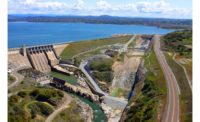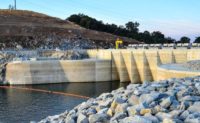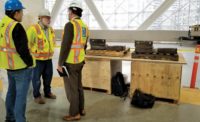After a Kiewit employee detected a leak early on Jan. 20 in a temporary cofferdam protecting workers and downstream interests on the $900-million Folsom Dam Auxiliary Spillway Project in California, the U.S. Army Corps of Engineers evacuated a dozen crew members and equipment while the U.S. Bureau of Reclamation (USBR) closed the bulkhead gates to prevent catastrophic flooding in the event of a cofferdam failure.
By the end of the day, emergency measures had stabilized the situation, and the contractor and project owners were determining how to progress without disrupting the project schedule.
Seepage in the 65-ft-tall, 850-ft-wide cofferdam originated 10 ft above the downstream toe, in the left groin of the temporary construction cofferdam, according to Katie Charan, Corps project manager on the joint effort with USBR, the Central Valley Flood Protection Board and the Sacramento Area Flood Control Agency. Prior to the event, the steady-state seepage from that region was approximately 10 to 20 gallons per minute.
The cause of the seepage was still unknown two days later. After three years of drought conditions, the Sacramento area has received 9.5 in. of rain since Jan. 1, according to the National Weather Service. Charan reported that the lake, which collects runoff from the Sierra Nevada Mountains, rose 30 ft in three weeks.
Once the seepage was contained by a 5,000-cu-yd rockfill berm pushed into place on the downstream face by a D9 dozer, crews returned to remove equipment, including a truck, generators and light stands, to remove the possibility of fuel contamination. “There were no environmental impacts,” Charan said.
Omaha-based Kiewit is the prime contractor for the $255.1-million fourth phase of the project, designed to reduce the risk of flooding in the Sacramento area by allowing for earlier releases of water from the structure, commissioned in 1955. The completed project will include a 1,100-ft water-side approach channel, a control structure with six submerged tainter gates, a 3,000-ft-long, concrete-lined spillway chute, and a 3,027-ft stepped spillway and stilling basin, to slow the water exiting the 340-ft-high, 1,400-ft-long concrete gravity dam into the American River, 25 miles northeast of Sacramento.
When the seepage was discovered, contractors were excavating material in the approach channel, finishing geological mapping and completing dry finish of concrete work. Kiewit’s project scope called for flooding the work area in mid-February, allowing water against the control structure by pumping water over the temporary cofferdam to equalize water on both sides of the structure. Then, crews were to finish excavation in the wet.
The contractor now is evaluating options for finishing the approach-channel work in the dry or in the wet, impounding water against the control structure earlier than anticipated.
“All work associated with the concrete structures will be completed in the dry. Remaining excavation work will be completed in the wet,” Charan said.
The auxiliary spillway is on track for completion in October 2017, Charan said. No delays are anticipated from this incident.






Post a comment to this article
Report Abusive Comment